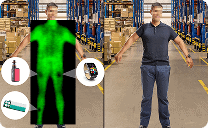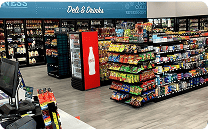In This article
Facial recognition uses advanced algorithms to detect, analyze, and compare human faces in images or video footage. When paired with modern security camera systems, it provides businesses and industrial facilities with automated identity verification and threat detection capabilities without requiring physical credentials or manual intervention.
Facial recognition typically starts with a camera capturing an image of a face. The image is processed by software to detect the face and extract key landmarks, such as the distance between the eyes, the shape of the cheekbones, the jawline, and other distinguishing features. These are used to create a unique mathematical representation known as a faceprint.
This faceprint can be matched against a stored database of images to verify or determine an individual’s identity. The applications for this are wide-ranging in the business and industrial world:
- Access Control: Facial recognition can replace or supplement keycards and PIN codes, offering hands-free, secure access to restricted areas.
- Intruder Detection: Security systems can cross-check live video against watchlists or employee databases, automatically alerting staff if an unauthorized person is detected.
- Time and Attendance Monitoring: Some organizations use facial recognition to log employee entry and exit times, reducing the possibility of buddy-punching and increasing accuracy.
- Loss Prevention: In high-value environments, systems can flag repeat offenders or known shoplifters as soon as they enter a facility.
The Role of AI in Facial Recognition
Artificial intelligence (AI), specifically machine learning and deep learning techniques, is at the core of modern facial recognition technology. AI trains software to recognize patterns in facial features with increasing accuracy, even under challenging conditions.
Modern AI-driven facial recognition systems use convolutional neural networks (CNNs) to analyze millions of facial data points. These networks are trained on vast datasets containing diverse faces across many angles, lighting conditions, ages, and expressions. Over time, the AI learns to distinguish between subtle variations, improving identification accuracy and speed.
AI also plays a critical role in real-time processing, allowing the system to scan video feeds from multiple cameras, detect faces in crowded or low-light environments, and make near-instant decisions. This is particularly useful for high-traffic commercial environments or industrial zones where fast response times are essential.
Some AI-enhanced systems go a step further, combining facial recognition with behavioral analysis or emotion detection. This can help security teams spot suspicious behavior or potential threats before an incident occurs.
Despite its benefits, facial recognition raises important privacy and ethical concerns. Depending on local laws, businesses may need to obtain consent, provide notice, or ensure individuals have the option to opt out of biometric data collection. Data must be securely stored and encrypted, and access to that data should be restricted and monitored.
It’s also worth noting that facial recognition is different from facial detection. While facial detection notes the presence of a face, facial recognition goes further by identifying or verifying who the face belongs to.
Facial recognition systems are becoming more accurate, reliable, and adaptable, making them a valuable asset in the toolbox of any organization serious about security, compliance, and operational efficiency.
Integrating Wireless Cameras with DTiQ’s Solutions
Wireless cameras are pivotal in modern surveillance strategies, offering flexibility and scalability. DTiQ enhances the capabilities of wireless camera systems by integrating them with our advanced intelligent video and analytics platform. Our 360iQ platform provides real-time monitoring, analytics, and seamless cloud storage, ensuring businesses can effectively manage and analyze video events from wireless cameras across multiple locations. By partnering with DTiQ, retail, c-stores, and QSRs can leverage the full potential of intelligent video solutions to improve security, operational efficiency, and decision-making processes.





























